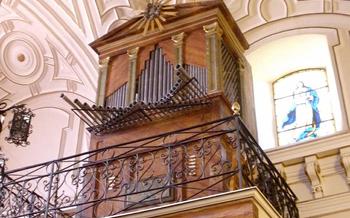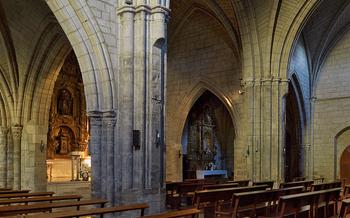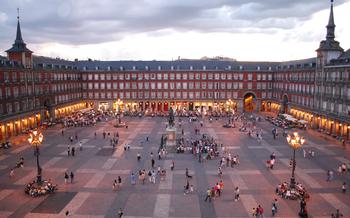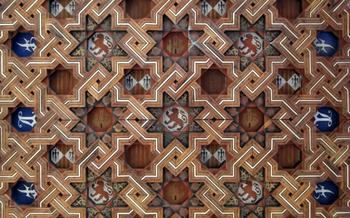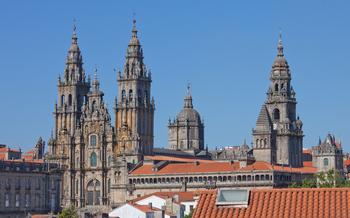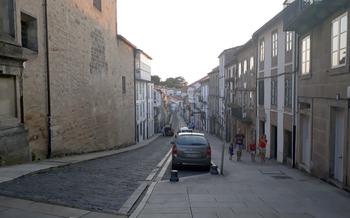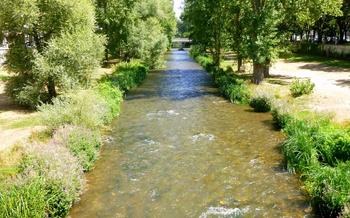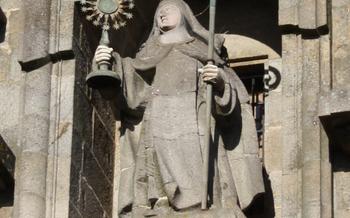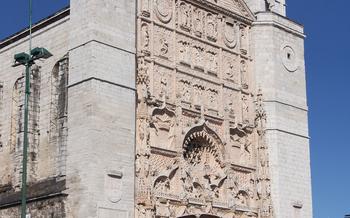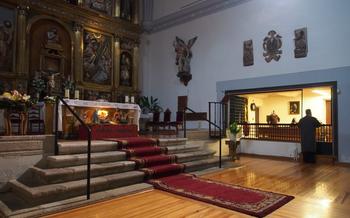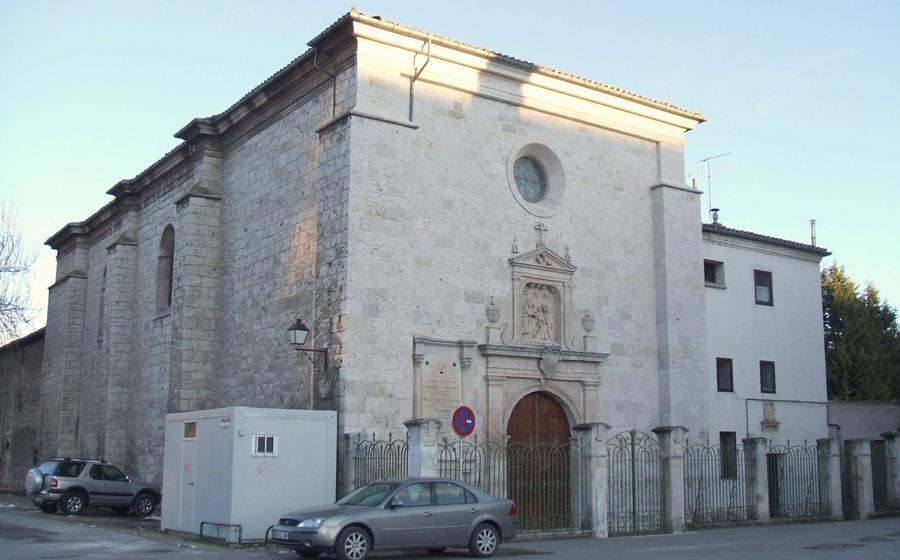
Convento de San José
- Burgos' Hidden Gem: Convento de San José
- A Journey Through Time: The History of the Convent
- Unveiling Architectural Masterpieces: The Exterior
- Exploring the Sacred Interior: The Church
- The Cloisters: A Haven of Tranquility
- Artistic Treasures: The Museum
- A Walk Through History: The Archives
- Music and Spirituality: The Choir
- The Nuns' Legacy: The Workshops
- Pilgrims' Path: The Camino de Santiago
- Local Celebrations: Fiestas and Traditions
- Practical Information: Planning Your Visit
- Literary Inspiration: The Convent in Literature
- Burgos' Culinary Delights: Where to Eat
- Insider Tip: Unveiling the Secret Garden
Burgos' Hidden Gem: Convento de San José
In the heart of Burgos, a city steeped in history and architectural wonders, stands a hidden gem that captivates visitors with its serene elegance and rich history: the Convento de San José. Founded in the 15th century by the Catholic Monarchs, Isabella I of Castile and Ferdinand II of Aragon, this convent has witnessed centuries of devotion, intrigue, and artistic excellence. With its stunning Gothic architecture, ornate interiors, and a tranquil atmosphere, the Convento de San José is a must-visit destination for travelers seeking a glimpse into the spiritual and cultural heritage of Burgos. Prepare to be mesmerized as we embark on a journey through time, uncovering the secrets and treasures that lie within the walls of this remarkable convent.
A Journey Through Time: The History of the Convent
The Convento de San José, a testament to the enduring power of faith, stands as a symbol of Burgos' rich religious heritage. Its story begins in the 13th century when the Dominican order, driven by a desire to spread the word of God, established a humble monastery on this very site. Over time, the monastery's reputation for piety and devotion grew, attracting the attention of influential patrons, including the Spanish monarchy.
In the 16th century, under the patronage of Queen Juana la Loca, the monastery underwent a remarkable transformation. The original structure was demolished, and in its place arose a grand and imposing convent, designed to accommodate a growing community of Dominican nuns. This ambitious project, overseen by skilled architects and artisans, marked the beginning of a new era for the Convento de San José.
As the years passed, the convent continued to expand and flourish, becoming a center of religious life and education for the women of Burgos. Its influence extended beyond the city walls, reaching far and wide across the region. The convent's wealth and prestige attracted generous donations from noble families, enabling it to acquire valuable works of art, religious artifacts, and an extensive library.
However, the convent's fortunes were not always favorable. In the 19th century, the Napoleonic Wars brought widespread destruction and upheaval to Spain, and the Convento de San José was not spared. The convent suffered significant damage, and its once-thriving community was scattered.
Despite these challenges, the spirit of the Convento de San José remained unbroken. In the decades that followed, the convent underwent a gradual process of restoration and renewal. Today, it stands once again as a vibrant and active religious community, welcoming visitors from around the world who seek to experience its rich history, stunning architecture, and enduring spiritual legacy.
Unveiling Architectural Masterpieces: The Exterior
Gothic Style:
The Convento de San José is a shining example of Gothic architecture, characterized by its soaring spires, ribbed vaults, and intricate ornamentation. The exterior walls are adorned with flying buttresses, which not only provide structural support but also create a sense of lightness and grace.
Intricate Details:
The facade of the convent is a testament to the skill and artistry of the medieval stonemasons. Every inch of the stonework is adorned with intricate carvings, depicting religious scenes, mythical creatures, and delicate floral motifs. These details add depth and texture to the building, inviting visitors to explore and discover the hidden stories within.
Bell Tower:
The bell tower, known as the "Torre de la Campana," is a prominent feature of the convent's exterior. It rises high above the surrounding buildings, offering panoramic views of the city of Burgos. The tower is topped with a weather vane adorned with the symbol of the Order of San José, a reminder of the convent's religious significance.
Courtyard:
In the heart of the convent lies a serene courtyard, surrounded by elegant Gothic arches. The courtyard is adorned with a central fountain and lush greenery, creating a tranquil oasis amidst the bustle of the city. It is a place for contemplation, relaxation, and connection with the natural world.
Exploring the Sacred Interior: The Church
Venturing inside the Convento de San José, visitors are greeted by a breathtaking spectacle—the church. This sacred space exudes an atmosphere of awe and devotion, showcasing the artistic prowess of its creators. The Baroque altarpiece, a masterpiece of intricate carving and gilding, captivates the eye with its depiction of religious scenes and celestial figures. Above, the stunning frescoes adorn the ceiling, narrating biblical tales and adding a touch of ethereal beauty to the interior. The ornate ceiling, with its intricate designs and vibrant colors, completes the visual feast, creating a sense of grandeur and opulence.
Beyond the altar, the church reveals another treasure—its stained glass windows. These masterpieces of artistry bathe the interior in a kaleidoscope of colors, casting a warm and inviting glow upon the sacred space. Each window tells a story, depicting scenes from the lives of saints, biblical events, or the history of the convent itself. Together, they create a mesmerizing spectacle that transports visitors to a realm of spirituality and history.
The Cloisters: A Haven of Tranquility
Stepping into the cloisters of the Convento de San José is like entering a serene sanctuary, where time seems to stand still. Gothic arches, intricately carved with biblical scenes and mythical creatures, frame a tranquil courtyard. Decorative tiles in vibrant shades of blue, green, and gold adorn the walls, adding a touch of color to the otherwise austere space. A central fountain, adorned with cherubs and gargoyles, provides a soothing soundtrack to this peaceful retreat.
In the center of the cloisters, a beautifully manicured garden offers a splash of greenery and a haven for contemplation. Roses, lavender, and jasmine fill the air with their sweet fragrance, while the gentle sound of birdsong creates a calming atmosphere. The cloisters provide a welcome respite from the hustle and bustle of the city, inviting visitors to slow down, reflect, and connect with their inner selves.
The cloisters served as a place of meditation and prayer for the nuns who once called the convent home. They would gather here to read, pray, and contemplate the divine. The serene atmosphere and beautiful surroundings were designed to foster a sense of spirituality and connection with God. Today, visitors can still experience the same sense of peace and tranquility that the nuns did centuries ago.
Artistic Treasures: The Museum
The Convento de San José is not merely a place of worship; it is also a treasure trove of art and history. Within its walls, visitors will find a museum dedicated to preserving and showcasing the convent's rich artistic heritage. The museum houses an impressive collection of paintings, sculptures, and religious artifacts that offer a glimpse into the artistic and spiritual life of the nuns who once called this place home.
A highlight of the museum is the collection of paintings, which includes works by prominent Spanish artists from the 16th to the 19th centuries. One can admire the masterful brushstrokes of El Greco, Zurbarán, and Goya, among others. The sculptures, carved from wood and stone, depict religious figures and scenes, showcasing the skill and artistry of local craftsmen.
The museum also houses a collection of religious artifacts, such as chalices, monstrances, and reliquaries. These beautifully crafted objects, adorned with intricate designs and precious stones, offer a glimpse into the rituals and ceremonies of the Catholic Church.
In addition to the permanent collection, the museum also hosts temporary exhibitions, featuring works from both local and international artists. These exhibitions offer an opportunity to explore contemporary art and its dialogue with the historical context of the convent.
A Walk Through History: The Archives
Delve into the depths of history as you step into the archives of the Convento de San José, a treasure trove of knowledge and stories waiting to be discovered. Among the meticulously preserved medieval documents, you'll find royal decrees, personal letters, and chronicles that offer a glimpse into the lives of those who once inhabited these hallowed halls. These precious manuscripts provide invaluable insights into the convent's rich past, its interactions with the outside world, and the profound impact it has had on the region throughout the centuries. Prepare to be captivated as you embark on a journey through time, unearthing the secrets and forgotten tales that lie within these ancient parchments.
Music and Spirituality: The Choir
The Convento de San José is renowned for its exceptional choir, a testament to the enduring power of music and spirituality. The choir's origins can be traced back to the convent's founding, when nuns gathered to sing Gregorian chant as part of their daily devotions. Over the centuries, the choir evolved, incorporating polyphonic music and organ concerts, captivating pilgrims and visitors alike.
The choir's repertoire is vast and diverse, encompassing sacred and secular works from the Middle Ages to the present day. Gregorian chant, with its haunting melodies and hypnotic rhythms, transports listeners to a time of deep faith and devotion. Polyphonic music, with its intricate harmonies and countermelodies, showcases the virtuosity of the choir members. Organ concerts, featuring both classical and contemporary compositions, fill the convent's sacred spaces with majestic sounds.
The choir's performances are not merely musical spectacles; they are profound spiritual experiences. The acoustics of the church, with its high vaulted ceilings and reverberant walls, create an immersive soundscape that envelops the listener. The voices of the choir blend seamlessly, rising and falling in perfect harmony, evoking a sense of awe and transcendence.
For those seeking a truly transformative experience, attending a choir performance at the Convento de San José is a must. It is an opportunity to immerse oneself in the beauty of sacred music, to connect with the divine, and to find solace and inspiration in the heart of this historic convent.
The Nuns' Legacy: The Workshops
Within the confines of the Convento de San José, the nuns have cultivated a rich tradition of artistic expression through their workshops. These workshops serve as a testament to their dedication, creativity, and enduring legacy.
Embroidery
The nuns have mastered the art of embroidery, creating intricate and colorful designs that adorn religious vestments, altar cloths, and tapestries. Their skillful hands weave threads of various hues, transforming fabrics into vibrant works of art.
Lace-making
The delicate craft of lace-making is another skill that the nuns have perfected. Using fine threads and intricate patterns, they create exquisite lace doilies, collars, and handkerchiefs. Each piece is a testament to their patience and precision.
Weaving
The nuns also engage in the art of weaving, using looms to create beautiful tapestries and rugs. These textiles often feature religious motifs or scenes from nature, adding a touch of warmth and spirituality to the convent's interior.
Preserving Traditions
Through these workshops, the nuns not only create beautiful objects but also preserve ancient traditions that have been passed down from generation to generation. Their dedication to these crafts ensures that these skills continue to thrive within the convent's walls.
Pilgrims' Path: The Camino de Santiago
The Convento de San José holds a special significance for pilgrims undertaking the historic Camino de Santiago, a network of ancient pilgrimage routes that lead to the Cathedral of Santiago de Compostela in Galicia, Spain. The convent serves as a welcome resting spot for weary travelers, offering shelter, sustenance, and spiritual guidance.
For centuries, pilgrims from all walks of life have traversed the Camino, seeking spiritual enlightenment, adventure, or simply a change of scenery. The convent's location along the French Way, the most popular route of the Camino, makes it a natural stopover for pilgrims seeking respite and rejuvenation.
Pilgrims are welcomed with open arms by the nuns of the convent, who provide them with food, lodging, and a chance to rest their weary bodies and minds. The convent's peaceful atmosphere and serene surroundings offer the perfect environment for pilgrims to reflect on their journey and connect with their inner selves.
The convent also serves as a spiritual sanctuary for pilgrims, providing them with the opportunity to attend Mass, pray, and seek guidance from the nuns. The convent's church, with its stunning Baroque altarpiece and intricate frescoes, invites pilgrims to immerse themselves in contemplation and devotion.
For many pilgrims, the Convento de San José represents a symbol of hope and renewal, a place where they can find solace, strength, and inspiration as they continue their journey along the Camino de Santiago.
Local Celebrations: Fiestas and Traditions
The Convento de San José is deeply intertwined with the local community and plays a central role in Burgos' vibrant cultural scene. Throughout the year, the convent hosts a variety of fiestas and traditional events that celebrate the city's rich heritage.
The most significant celebration is the feast day of Saint Joseph, the convent's patron saint, held on March 19th. This day is marked by a solemn mass, a colorful procession through the streets of Burgos, and lively festivities that showcase the city's folklore and traditions. The nuns of the convent prepare special pastries and dishes to share with the community, fostering a sense of unity and camaraderie.
Other notable events include the Semana Santa (Holy Week) processions, where the convent's pasos (religious floats) are carried through the streets, accompanied by solemn music and prayer. The Corpus Christi procession, held in June, is a vibrant display of faith and devotion, as the streets are adorned with colorful carpets of flowers and the Eucharist is carried in a grand procession.
The convent also hosts cultural events throughout the year, such as concerts, exhibitions, and workshops, which provide opportunities for visitors to engage with the local community and experience the diverse cultural offerings of Burgos. These events showcase the city's rich artistic heritage and provide a glimpse into the daily lives of the nuns and the local people.
Practical Information: Planning Your Visit
Opening Hours: The Convento de San José is open to the public from Tuesday to Sunday, with varying hours depending on the season. During the summer months (June to September), the convent is open from 10:00 am to 1:00 pm and from 4:00 pm to 7:00 pm. In the winter months (October to May), the hours are from 10:00 am to 1:00 pm and from 3:00 pm to 6:00 pm. It is closed on Mondays and major holidays.
Admission Fees: Entrance to the convent is free of charge for all visitors. However, donations are welcome and greatly appreciated, as they help to maintain and preserve this historic site.
Guided Tours: Guided tours of the convent are available upon request and are highly recommended for those who want to learn more about its history, architecture, and significance. Tours are conducted in Spanish and English and must be booked in advance.
Accessibility: The Convento de San José is wheelchair accessible, with ramps and elevators providing access to all areas of the convent, including the church, cloisters, and museum.
Literary Inspiration: The Convent in Literature
The Convento de San José has captured the imagination of writers and poets throughout history, inspiring literary works that delve into its rich history and spiritual atmosphere. In his historical novel "The Cid," Spanish writer Arturo Pérez-Reverte brings to life the era of the Reconquista, with the convent serving as a backdrop for epic battles and tales of chivalry. Another notable work is the poem "The Convent of San José" by local poet Federico García Lorca, which paints a vivid picture of the convent's serene cloisters and the nuns' devotion. The convent's mystique has also found its way into legends and folklore, passed down through generations by the people of Burgos. These stories often intertwine history and imagination, creating a captivating tapestry of the convent's past.
Burgos' Culinary Delights: Where to Eat
No visit to Burgos is complete without savoring the city's culinary treasures. From traditional Spanish cuisine to local specialties, Burgos offers a diverse range of dining options to satisfy every palate.
At Casa Ojeda, indulge in mouthwatering tapas and traditional Castilian dishes prepared with fresh, seasonal ingredients. Their specialty, "Morcilla de Burgos", a unique blood sausage, is a must-try.
For a taste of local delicacies, head to Restaurante Casa Curro. Their "Cordero Asado", slow-roasted lamb, is a regional favorite, while their "Judiones de La Granja", large white beans, are a hearty and comforting dish.
Vegetarian and vegan travelers will find plenty of options at La Vegana Burgos. Their creative plant-based dishes, such as their "Paella de Verduras", vegetable paella, and their "Hamburguesa de Quinoa", quinoa burger, are both delicious and nutritious.
For a truly unique dining experience, book a table at Restaurante El Claustro. Located within the Convento de San José, this restaurant offers a fusion of traditional and modern cuisine, with a focus on seasonal, locally sourced ingredients. Their "Cochinillo Confitado", confit suckling pig, is a signature dish that showcases the region's culinary heritage.
No matter your culinary preferences, Burgos has something to offer every foodie. From traditional Spanish fare to innovative vegetarian dishes, the city's dining scene is sure to delight and satisfy.
Insider Tip: Unveiling the Secret Garden
Beyond the cloisters, tucked away from the main courtyard, lies a hidden gem—the secret garden of the Convento de San José. This secluded oasis offers a tranquil escape from the bustling city, inviting visitors to immerse themselves in nature's tranquility.
The garden, meticulously maintained by the nuns, boasts an array of aromatic plants, vibrant flowers, and towering trees. The air is filled with the sweet scent of roses, lavender, and jasmine, creating a sensory experience that soothes the soul.
Strolling along the winding paths, visitors can admire the colorful blooms, pause to read inspirational quotes inscribed on stone tablets, or simply find a quiet spot to sit and reflect. A small fountain in the center of the garden provides a serene backdrop, its gentle murmur adding to the peaceful ambiance.
This secret garden is a testament to the nuns' deep connection with nature and their commitment to preserving its beauty. It serves as a reminder of the importance of seeking moments of peace and tranquility amidst the demands of daily life.
Whether you're a nature enthusiast, a seeker of spiritual solace, or simply looking for a hidden gem off the beaten path, the secret garden of the Convento de San José is a place that will leave you feeling refreshed and inspired.
